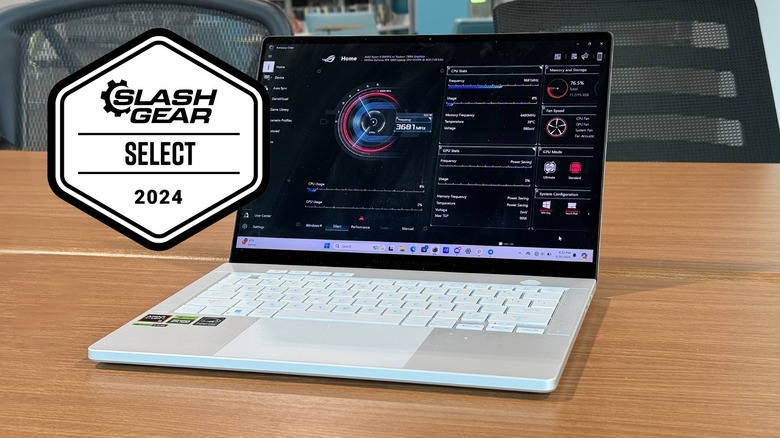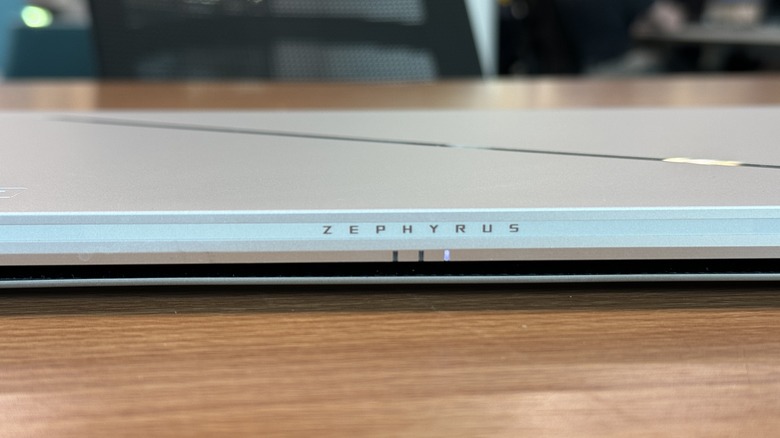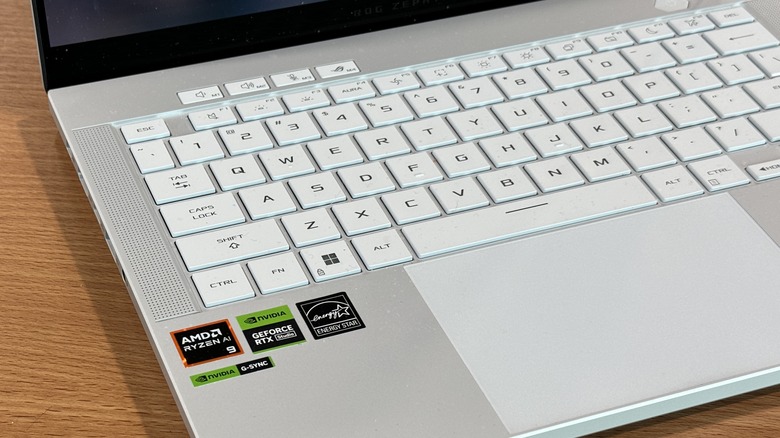From www.slashgear.com

Adam Doud/SlashGear
By Adam Doud/
EDITORS’ RATING : 8 / 10
- Understated design (for a gaming laptop)
- Plenty of power
- Great keyboard
- Booming speakers
- Discrete GPU
- Can’t do a full day on battery
- Maybe not flashy enough for some shoppers
- Big bezels
We may receive a commission on purchases made from links.
Gaming laptops have a certain reputation associated with them. They tend to be powerful and have a relatively short battery life. They also tend to have some crazy design language designed to make them stand out in a crowd. When you sit down with a gaming laptop, it’s almost like you want people to notice that your computer doesn’t have a bitten apple on it. When it comes to the ASUS Zephyrus G14, you might do a double-take.
Aside from the tell-tale light-up slash across the back, and the Republic of Gamers (ROG) logo, you could easily mistake this laptop for one coming out of Cupertino. It’s a little bit thicker, but the aluminum build makes it resemble its cousin from Apple.
But under the hood, they couldn’t be more different. In addition to a professional, discreet industrial design, the ASUS Zephyrus G14 carries powerful performance, a discrete GPU, and some of the usual gaming characteristics you know and love from the genre. It’s a very capable laptop that powers through the day but needs to find a plug before that day is over. This review was written after two weeks with a review sample provided by ASUS.
Quality Build

Adam Doud/SlashGear
The first thing you’ll notice about the Zephyrus G14 laptop is that it retains much of its gamer DNA, but largely in an understated way. You don’t get flashing RGB lights on the back, nor a light-up logo. Instead, you get a diagonal slash across the back that can light up when you want it to. It gives it a flashy feel without being too in your face about it.
The aluminum unibody build is great for a premium look and feel. The laptop comes in Eclipse Grey or Platinum White (as reviewed). Once you open the lid — which passes the one-hand opening test, by the way — you still get some gamer characteristics, but again, they’re understated, and look like they belong on “a laptop,” not necessarily “a gaming laptop.”
The most notable characteristic is the uneven hexagon power button in the upper right corner of the keyboard deck. Above the keyboard are four extra keys that allow you to adjust the volume on the speakers that flank both sides of the laptop. A very large trackpad dominates the bottom of the keyboard.
As for what’s under the hood, as reviewed the ASUS Zephyrus G14 comes with an AMD Ryzen 9 8945H processor, 16 GB of RAM, 1 TB of storage, and an NVIDIA GeForce RTX 4060 GPU. All told it’s not the most powerful laptop out there, but it can get the job done when pushed.
Great keyboard and booming sound

Adam Doud/SlashGear
The keyboard is a good size with excellent pitch and travel for the keys. A 14-inch laptop is usually a pretty good size to hold a good-sized keyboard, though it might feel a tad cramped for larger people. The chicklet-style keys are responsive with great feedback, even for aggressive typists.
The font on the keyboard isn’t the standard Helvetica you’ll see on most keyboards — this set of keys has just enough character to remind you that this is a gaming laptop, without rubbing it in. It’s around this point that you’ll catch on to the theme. The only qualm I have about the keyboard is the inclusion of half-sized arrow keys in the bottom right corner of the laptop. Those kinds of keys tend to be polarizing; you’ll either love them or hate them.
Flanking either side of the keyboard are the speaker grilles for the upward-firing speakers. These speakers are among the best you’ll find on a laptop, which is the good news. The bad news is, it’s a low bar. The speakers get really good range and a solid sound stage, and even your hands typing on the keyboard do little to muffle the sound.
The speakers can get a bit hollow sounding, depending on the genre of music you’re listening to, but overall, there’s very little to complain about here. In terms of volume, they get extremely loud. You won’t want to turn them up much past 50% because they’re already irritating your housemates at that level.
The only thing missing from the speakers is that super-deep bass from dubstep music. Beyond that, you get a full range of tones, making you want to skip the earbuds when you want to listen to music while working.
Awesome display

Adam Doud/SlashGear
ASUS is bringing a 14-inch OLED display to the table with a 120 Hz refresh rate, a maximum of 500 nits of peak brightness, and a 16:10 aspect ratio. It’s possible to use the laptop outside, but you’ll need to find some favorable shadows to do so. Maxing out your brightness will adversely affect your battery as well, so bear that in mind.
Overall, the display is quite good, though it’s not a touchscreen, which is a bit of a bummer. The display is flanked by some not-insignificant bezels on every side. On top, the bezel hides the Windows Hello-complaint 1080p IR webcam, so you can’t complain about that one, but the sides and bottom bezels are fairly large by modern standards. It’s not necessarily a deal-breaker, but it is certainly noteworthy.
As for the picture quality, it’s quite good with a sharp picture and really deep blacks. ASUS developed a set of standards for ROG laptops called the “ROG Nebula Display,” which is essentially a set of benchmarks that panel manufacturers need to meet to make it onto an ROG laptop. Those standards include things like refresh rates (120 Hz), response times (3 ms max), brightness (at least 500 nits), and the like. The goal is to get ROG laptop component manufacturers and customers on the same page.
Software and the Armory Crate

Adam Doud/SlashGear
Just like the ASUS ROG Phone 8 Pro, the Asus Zephyrus 14 laptop comes with an Armory Crate, which is your one-stop shop for all things performance, gaming, and customization. This Armory crate has settings like audio controls, video controls, performance settings, lighting customizations, and more. It’s your gateway into making your computer yours and no one else’s. It can also scan your computer and become your central archive of all the games on your PC.
Aside from the Armory Crate, the laptop ships with Windows 11. The good news is it doesn’t pile much extra software on top of Windows 11. Some computer manufacturers will come with a free trial of an anti-virus software suite that pesters you like a chihuahua on a double espresso to try to get you to subscribe. There’s none of that here, which is refreshing. That being said, aside from the Armory Crate, ASUS ships MyASUS and Aura Creator, along with software for other components, like NVIDIA Control Panel and Realtek Audio console.
One oddity that you’ll notice is the large number of updates you’ll need to download. It seems like there’s a new update requiring a restart for the laptop every day, and sometimes multiple days. All told, since February 26th (about one month ago as of this writing), there have been a total of 33 updates installed, though not all of those required a restart. But still, it’s a lot.
I/O and power

Adam Doud/SlashGear
The 2024 Zephyrus G14 has a ton of ports that should cover basically any need you might have. On the left, you get a USB 4.0 100W power delivery port, a Type-A USB 3.2 port, a full-sized HDMI 2.1 port, and a 3.5mm audio jack. On the other side, there are two USB 3.2 ports (Type-A and Type-C) and a microSD card reader.
The aforementioned power port is not a typical USB-C or Type-A port, though the computer can accept a charge through its USB-C port. The power cable is a fairly substantial brick-on-a-string that’s just as big and twice as thick as a Samsung Galaxy S24.
On battery, the laptop lasts for around seven and a half hours before it hits power saver mode. That’s actually not bad considering the power this laptop packs. This would be a good laptop to travel with because you get that much battery life out of it when you need to wander away from the outlet, and you have power to spare when you’re plugged in.
ASUS Zephyrus G14 Price, availability, and final verdict

Adam Doud/SlashGear
The ASUS Zephyrus G14 is available from multiple retail outlets including ASUS.com and Amazon, but this particular review sample build is exclusive to Best Buy and is available now for $1,599. That’s not bad for a gaming laptop, especially one with a discrete GPU. It’s certainly on the high end of your “average, everyday laptop” but if you want a machine with some extra power, it’s easy to imagine that price being on the cheap side.
For that, you get a high-quality build, a lovely typing experience, and some of the best speakers you’re going to hear on a laptop. Granted, that’s a low bar, but you will still enjoy the sound on this laptop immensely. Add to that the understated design that belongs in a boardroom, as much as it belongs at a “Fortnite” tournament.
Once you open the laptop, that’s when the fun starts. The backlit keyboard is customizable and delightful. The computer is quick and responsive. There’s no lag. You might notice the lack of a touchscreen here, which most will either take or leave.
The real value here is a laptop that can do anything you need it to, and live off a full battery charge for a substantial part of an average workday. Once you’re home, the ASUS Zephyrus G14 puts a cherry on top by meeting or exceeding the value you’d expect for the cash you’ve put into it.
[ For more curated Computing news, check out the main news page here]
The post ASUS ROG Zephyrus G14 (2024) Review: A Truly Discreet Gaming Laptop – SlashGear first appeared on www.slashgear.com





/cdn.vox-cdn.com/uploads/chorus_asset/file/25546355/intel_13900k_tomwarren__2_.jpg)








